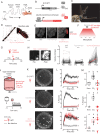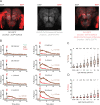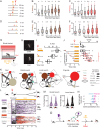A persistent behavioral state enables sustained predation of humans by mosquitoes
- PMID: 35550041
- PMCID: PMC9154740
- DOI: 10.7554/eLife.76663
A persistent behavioral state enables sustained predation of humans by mosquitoes
Abstract
Predatory animals pursue prey in a noisy sensory landscape, deciding when to continue or abandon their chase. The mosquito Aedes aegypti is a micropredator that first detects humans at a distance through sensory cues such as carbon dioxide. As a mosquito nears its target, it senses more proximal cues such as body heat that guide it to a meal of blood. How long the search for blood continues after initial detection of a human is not known. Here, we show that a 5 s optogenetic pulse of fictive carbon dioxide induced a persistent behavioral state in female mosquitoes that lasted for more than 10 min. This state is highly specific to females searching for a blood meal and was not induced in recently blood-fed females or in males, who do not feed on blood. In males that lack the gene fruitless, which controls persistent social behaviors in other insects, fictive carbon dioxide induced a long-lasting behavior response resembling the predatory state of females. Finally, we show that the persistent state triggered by detection of fictive carbon dioxide enabled females to engorge on a blood meal mimic offered up to 14 min after the initial 5 s stimulus. Our results demonstrate that a persistent internal state allows female mosquitoes to integrate multiple human sensory cues over long timescales, an ability that is key to their success as an apex micropredator of humans.
Keywords: Aedes aegypti mosquito; behavior; blood feeding; genetics; genomics; machine learning; neuroscience; optogenetics; persistent state.
© 2022, Sorrells et al.
Conflict of interest statement
TS, AP, AR, LV No competing interests declared
Figures










Similar articles
-
Fruitless mutant male mosquitoes gain attraction to human odor.Elife. 2020 Dec 7;9:e63982. doi: 10.7554/eLife.63982. Elife. 2020. PMID: 33284111 Free PMC article.
-
General Visual and Contingent Thermal Cues Interact to Elicit Attraction in Female Aedes aegypti Mosquitoes.Curr Biol. 2019 Jul 8;29(13):2250-2257.e4. doi: 10.1016/j.cub.2019.06.001. Epub 2019 Jun 27. Curr Biol. 2019. PMID: 31257144
-
Carbon dioxide and blood-feeding shift visual cue tracking during navigation in Aedes aegypti mosquitoes.Biol Lett. 2022 Sep;18(9):20220270. doi: 10.1098/rsbl.2022.0270. Epub 2022 Sep 28. Biol Lett. 2022. PMID: 36166270 Free PMC article.
-
A meta-analysis reveals that dragonflies and damselflies can provide effective biological control of mosquitoes.J Anim Ecol. 2023 Aug;92(8):1589-1600. doi: 10.1111/1365-2656.13965. Epub 2023 Jun 4. J Anim Ecol. 2023. PMID: 37272224 Review.
-
Mosquito Host-Seeking Regulation: Targets for Behavioral Control.Trends Parasitol. 2019 Sep;35(9):704-714. doi: 10.1016/j.pt.2019.06.010. Epub 2019 Jul 17. Trends Parasitol. 2019. PMID: 31326312 Review.
Cited by
-
Cross-modal sensory compensation increases mosquito attraction to humans.Sci Adv. 2025 Jan 3;11(1):eadn5758. doi: 10.1126/sciadv.adn5758. Epub 2025 Jan 1. Sci Adv. 2025. PMID: 39742477 Free PMC article.
-
Multisite regulation integrates multimodal context in sensory circuits to control persistent behavioral states in C. elegans.Nat Commun. 2023 May 26;14(1):3052. doi: 10.1038/s41467-023-38685-1. Nat Commun. 2023. PMID: 37236963 Free PMC article.
-
Aedes albopictus is not an arbovirus aficionado when feeding on cynomolgus macaques or squirrel monkeys.iScience. 2024 Oct 19;27(11):111198. doi: 10.1016/j.isci.2024.111198. eCollection 2024 Nov 15. iScience. 2024. PMID: 39555418 Free PMC article.
-
Context-dependent effects of carbon dioxide on cross-modal integration during mosquito flight.Sci Rep. 2025 Aug 20;15(1):28139. doi: 10.1038/s41598-025-13427-z. Sci Rep. 2025. PMID: 40835859 Free PMC article.
-
Behavioral heterogeneity in host-seeking and post-feeding suppression among disease vector mosquitoes.bioRxiv [Preprint]. 2025 Jun 24:2025.06.18.660345. doi: 10.1101/2025.06.18.660345. bioRxiv. 2025. PMID: 40667366 Free PMC article. Preprint.
References
-
- Anholt BR, Ludwig D, Rasmussen JB. Optimal pursuit times: How long should predators pursue their prey? Theoretical Population Biology. 1987;31:453–464. doi: 10.1016/0040-5809(87)90015-3. - DOI
Publication types
MeSH terms
Substances
Grants and funding
LinkOut - more resources
Full Text Sources
Research Materials
Miscellaneous

